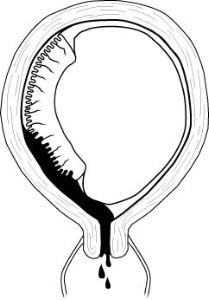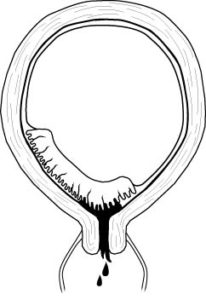a. Definition/Causes. Antepartum hemorrhage is the patient hemorrhaging before delivery.
Three major causes of this condition are placenta abruptio, placenta previa, and uterine rupture.
(1) Placenta abruptio. In this condition, the placenta separates from the wall of the uterus. The separation usually occurs during the last two months of pregnancy.
When the placenta separates from the uterine wall, placenta blood vessels rupture, and spontaneous bleeding starts. The mother may go into shock, and the fetus may not have enough oxygen. Signs of this condition include abdominal pain and rapid onset of labor. The uterus becomes rigid. To treat, transport the mother immediately to a hospital and treat for shock.
(2) Placenta previa. Here, the presenting part is the placenta. Since the placenta has many blood vessels, a massive hemorrhage may occur.
(3) Uterine rupture. A uterine rupture is a tearing of a part of the uterus. The patient has sudden, severe abdominal pain, and a rigid abdomen. Bleeding may not be apparent externally, but the patient can have profound shock from internal hemorrhage.
CAUTION: DO NOT attempt to examine the patient internally, regardless of the cause of antepartum hemorrhage.
b. Management of Antepartum Hemorrhage. Manage as follows:
(1) Place the patient flat on a stretcher, lying on her side.
(2) Administer oxygen to the patient.
(3) Start at least two large-bore IV lines. Give crystalloid or colloid as rapidly as needed to maintain the patient’s blood pressure.
(4) To treat for shock, it may be necessary to apply a MAST garment. If so, inflate the leg sections only of this garment.

